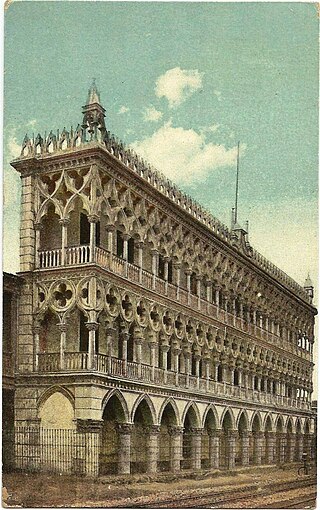
Surquillo is a district located in Lima, Peru. The district is bordered by the districts of San Isidro and San Borja on the north; by Miraflores on the south and west; and by Santiago de Surco on the east.

The Historic Centre of Lima is the historic city centre of the city of Lima, the capital of Peru. Located in the city's districts of Lima and Rímac, both in the Rímac Valley, it consists of two areas: the first is the Monumental Zone established by the Peruvian government in 1972, and the second one—contained within the first one—is the World Heritage Site established by UNESCO in 1988, whose buildings are marked with the organisation's black-and-white shield.

Centro is a barrio of Montevideo, Uruguay. Its main axis is 18 de Julio Avenue, and it runs between Plaza Independencia and Ejido St, being the central business district.

The Plaza San Martín is one of the most representative public spaces of the city of Lima, Peru. It is located at the ninth block of Colmena avenue, within the Historic Centre of Lima which was declared a World Heritage Site in 1988 by UNESCO. It is located near the Plaza Mayor of Lima and is connected to it by the Jiron de la Union. Its central monument gives homage to Peru's liberator, José de San Martín.

Ryszard Jaxa-Małachowski Kulisicz, later known as Ricardo de Jaxa Małachowski, was a Polish-Peruvian architect, active in Peru for nearly all of his professional career. He was one of the major architects of the capital city of Lima, working in the design and construction of over 15 major buildings in the city.

Cibeles Palace, formally known as Palacio de Comunicaciones and Palacio de Telecomunicaciones until 2011, is a complex composed of two buildings with white facades and is located in one of the historical centres of Madrid, Spain. Formerly the city's main post office and telegraph and telephone headquarters, it is now occupied by City Council of Madrid, serving as the city hall, and the public cultural centre CentroCentro.

The Park of the Exhibition, known between 1999 and 2004 as the Grand Park of Lima, is a park located in the neighbourhood of Santa Beatriz, itself part of the buffer zone of the historic centre of Lima, Peru. It was built to replace the city's walls, demolished as part of a citywide renovation project in order to host an international exhibition in 1872.

Limatambo International Airport(IATA: LIM, ICAO: SPIM) was an airport of Lima, Peru that operated from its inauguration by Óscar R. Benavides in 1935 until its closure on New Year's Day of 1964, when it was replaced by the Jorge Chávez International Airport in Callao. Today, the terminal is the headquarters of the Ministry of the Interior of Peru, and the runways are incorporated within the city as the Guardia Civil and José Gálvez Barrenechea avenues.

The Palace of the Counts of Maceda, or Casa del Barón in Pontevedra, Spain, is an original Renaissance pazo dating from the 16th century. It is currently a four-star hotel belonging to the Paradores network.

Virginia Tovar Martín (1929–2013) was a Spanish art historian, author, and professor. She was a foremost scholar in the study of architecture and urban planning of Madrid during the Baroque period. Tovar Martín was a Professor of History of Art at the Complutense University of Madrid; and at Autonomous University of Madrid.

The Palacio de la Magdalena is a viceregal house located in the district of Pueblo Libre in Lima. It is located near the Plaza de los Libertadores, and is also known as the Quinta de los Libertadores. The building was declared a national monument in 1972.

The Limatambo Building, also known as the Seoane Building, was a building in San Isidro District, Lima. The building was known for its billboards, most of which promoted the Coca-Cola Company.
Enrique Buenaventura Juan Seoane Ros was a Peruvian modernist architect of the 20th century.

The Embassy of the United States in Lima is the official diplomatic mission of the United States of America to the Republic of Peru. The chancery is located in the upper-scale district of Santiago de Surco since 1995.

The Paseo de la República Avenue, officially the Vía Expresa Luis Fernán Bedoya Reyes since 2019 and also known by its nickname, El Zanjón, is the most representative avenue of Lima, Peru. It crosses the districts of Lima, Lince, La Victoria, San Isidro, Surquillo, Miraflores, Barranco and Chorrillos from north to south along 66 blocks. COSAC I of the Metropolitano extends along its entire length, being one of the widest avenues in the city and country.

The Venetian Palace, also known as the Casa Concha or Casa Concha Astete, was a palace in the historic centre of Lima District. The building, inspired by the Doge's Palace of Venice and located in the vicinity of the Puente de Piedra and the Government Palace, was ultimately demolished by the military government of Manuel A. Odría.

Santa Beatriz is a neighbourhood in Lima District. It is the southernmost area of the district. It limits to the north, with the historic centre of Lima; to the east, with La Victoria; to the south, with Lince; and to the west, with Jesús María.

Jirón Camaná is a major street in the Damero de Pizarro, located in the historic centre of Lima, Peru. The street starts at the Alameda Chabuca Granda and continues southwest until it reaches Jirón Jacinto López, next to the Plaza Francia, continuing directly south until it reaches Bolivia Avenue, next to the Lima Civic Center.
Alonso Alegría Amézquita is a Peruvian playwright and theatre director. The son of journalist Ciro Alegría, he is known for his work in Nubeluz.



















